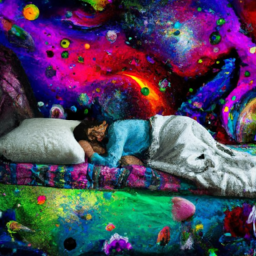Did you know that on average, a person spends six years of their life dreaming? This is a substantial amount of time spent in a different reality where anything is possible. But have you ever thought about why we dream and what their true meaning is?
There are many theories out there, each with its own explanation for why we dream and what purpose it serves. In this article, I will be discussing one specific theory of dreaming – the Activation-Synthesis Theory – which claims that dreams are simply random by-products of brain processes during sleep.
The Activation-Synthesis Theory was first proposed by J. Allan Hobson and Robert McCarley in 1977, and it has since become one of the most widely accepted explanations for the phenomenon of dreaming. According to this theory, when we sleep, our brains continue to generate neural activity even though our bodies are at rest.
This neural activity creates random images, sounds, and sensations that our brains then try to make sense of by weaving them into a narrative. In other words, our dreams are not intentional or meaningful – they are simply the result of our brains trying to create order out of chaos during sleep.
Key Takeaways
- The theory that claims dreams are random by-products of brain processes during sleep is called the Activation-Synthesis Theory.
- Dreams are not intentional or meaningful according to this theory.
- Dreams may appear nonsensical or random but are still a product of the brain attempting to create meaning out of sensory input.
- There is no specific pattern or theme in dreams, and they are not significantly related to waking life experiences or emotions.
Overview of Dream Theories
So, you may be wondering what all these dream theories are about and how they relate to your own nighttime adventures. Well, let’s start with the theory that suggests dreams are just random brain activity during sleep – this one proposes that there’s no real meaning or purpose behind your dreaming. According to this view, dreams are simply by-products of the brain’s natural processes during sleep. This means that the bizarre imagery and seemingly random events in your dreams have no real explanation or symbolism.
However, it’s important to note that some cultures place a significant amount of importance on interpreting dreams and their symbolism. For example, many Native American tribes believe that dreams can provide guidance and insight into an individual’s life path. Despite cultural differences in understanding the significance of dreaming, the theory of random brain activity during sleep remains widely accepted among scientists and researchers.
Moving forward, we will explore another prominent theory known as the activation-synthesis theory which provides a different perspective on why we dream.
The Activation-Synthesis Theory
The Activation-Synthesis theory suggests that our brains generate dream experiences from random signals. This theory proposes that during sleep, the brain undergoes various neurological processes which result in the generation of random signals or electrical impulses. These signals are then interpreted by the brain, leading to dream experiences.
To further explain this theory, I have created a table below:
| Column 1 | Column 2 | Column 3 | Column 4 | Column 5 |
|---|---|---|---|---|
| Brain generates random signals | During sleep | Neurological processes | Signals are interpreted by the brain | Dream experiences are formed |
As seen in the table, there is a direct relationship between each column which reinforces the idea behind The Activation-Synthesis Theory. While some may argue that dreams hold deeper meaning and symbolism, this theory suggests otherwise. However, it’s worth noting that dream interpretation can still provide insight into one’s subconscious thoughts and emotions.
Moving on to the next section about ‘explanation of the theory’, we will delve deeper into how this process occurs during sleep.
Explanation of the Theory
Understanding how the Activation-Synthesis Theory works involves exploring the neurological activity that occurs in your brain while you dream. According to this theory, dreaming is a result of random neural firing in the brainstem and cerebral cortex during REM sleep. These random signals are then interpreted by the brain as meaningful experiences, resulting in dreams.
However, this theory has its limitations. It doesn’t explain why certain recurring themes or symbols occur in dreams or why some people have more vivid dreams than others. Additionally, alternative perspectives suggest that dreams serve a purpose for problem-solving or emotional processing rather than simply being random by-products of brain processes during sleep.
Nevertheless, studying neural activity during sleep can provide further insight into the mechanisms behind dreaming and its various functions.
Neural Activity during Sleep
Explore how our brains remain active during the night, revealing fascinating insights into the mysteries of sleep. While we are asleep, our brain goes through different sleep stages which are characterized by distinct patterns of neural activity. These stages include non-REM (NREM) and REM cycles, with each stage having a specific function that contributes to our overall health and well-being.
During NREM sleep, the brain’s electrical activity slows down as it transitions from wakefulness to sleep. This stage is critical for restoring energy levels, repairing tissues, and consolidating memories. On the other hand, REM sleep is characterized by rapid eye movements and an increase in brain activity similar to that seen during wakefulness. This stage is essential for processing emotional information and dreaming. As we cycle through these stages throughout the night, our brains continue to work hard to maintain optimal functioning even when we are unaware of it. The table below summarizes the different characteristics of NREM and REM cycles.
| Sleep Stage | Brain Activity | Eye Movement | Muscle Tone |
|---|---|---|---|
| NREM | Slow-wave activity | None | Decreased |
| REM | High-frequency waves | Rapid | Atonic (paralyzed) |
As we delve deeper into understanding how our brain works during sleep, we begin to unravel some of the mysteries surrounding dreaming. However, it’s important to note that dreams are not just random by-products of brain processes but rather a result of our brain trying to make sense of input received during waking life.
Brain Trying to Make Sense of Input
Imagine how your mind tries to piece together and make sense of all the information it receives during your waking life, creating a unique and personal narrative in your dreams. During sleep, the brain continues processing sensory input but without external stimulation.
This means that the brain has to rely on its own internal processes to create meaning out of the random signals it is receiving. To better understand this process, consider these five points:
- The brain is constantly trying to find patterns and connections between different pieces of information.
- Without external input, the brain may attempt to fill in any gaps or missing details with its own creative interpretation.
- Dreams often incorporate elements from our daily lives, even if they are distorted or exaggerated.
- Our emotions can greatly influence dream content and interpretation.
- Dreaming is not limited to just visual images but can also include sounds, smells, and physical sensations.
As a result of this brain processing during sleep, dreams may appear nonsensical or random. However, they are still a product of our brains attempting to create meaning out of sensory input without external stimuli.
In the next section, we’ll explore how this process leads to the creation of random images, sounds, and sensations in our dreams.
Creation of Random Images, Sounds, and Sensations
The brain’s attempt to piece together sensory input during sleep can result in the creation of bizarre and unpredictable dream experiences. This random dream generation is a function of brain processing during sleep that creates images, sounds, and sensations that aren’t grounded in reality.
Research has shown that up to 70% of dreams contain at least one instance of illogical or impossible content. This supports the theory that dreams are simply by-products of neural activity.
In addition to being random, dreams lack meaning in many cases. Despite years of study, researchers haven’t found consistent patterns or symbols in dreams that suggest they have any deeper psychological significance.
This lack of meaning may be frustrating for those who seek insight into their own minds through dreaming, but it also highlights the fact that dreams are simply a natural occurrence of the sleeping brain. Regardless of their content or frequency, dreams serve as a reminder that our brains continue to work even when our conscious minds shut down for the night.
Lack of Meaning in Dreams
You might feel disappointed when you wake up and realize that the vivid dream you just had lacked any sort of meaningful symbolism or interpretation. This lack of meaning in dreams is a key aspect of the theory that dreams are simply random by-products of brain processes during sleep. According to this view, there is no underlying psychological or cultural significance to our dream content.
Many people find this idea difficult to accept, as we tend to attribute great importance to our dreams and often seek out symbolic interpretations for them. However, proponents of the random-byproduct theory argue that such interpretations are merely an attempt to impose meaning on something that has none.
While it may be unsettling to think that our dreams are ultimately meaningless, accepting this possibility can help us better understand the complex workings of our brains during sleep.
Scientific support for the theory comes from studies showing that brain activity during REM sleep (when most dreaming occurs) is similar to activity during waking hours, suggesting that dream content may arise from random firing of neurons rather than deliberate processing. Additionally, research has shown that individuals from different cultures may interpret dream symbols differently, further supporting the notion that symbols are not inherently meaningful but rather shaped by social and cultural factors.
With these findings in mind, it becomes easier to accept the idea that our dreams may simply be a product of neural activity without any deeper significance beyond what we ascribe to them.
Scientific Support for the Theory
Supported by scientific research, it becomes easier to accept the idea that our dreams may simply be a result of brain processes during sleep without any specific meaning. The theory of dream randomness has been supported by various studies that suggest an absence of purpose in dreams.
Using electroencephalography (EEG), researchers have observed that during REM sleep, the activity in the brain’s frontal lobe decreases while the activity in other areas increases, leading to random neural firings and ultimately resulting in dream content.
Furthermore, recent research has also shown that there is no specific pattern or theme in dreams. A study conducted on college students found that their dreams were not significantly related to their waking life experiences or emotions. This supports the idea that dreams are simply a by-product of neural activity rather than a reflection of our deepest desires or fears.
Understanding this theory can have significant implications for understanding dreams beyond what we attribute to them and how they affect our daily lives.
Implications for Understanding Dreams
Understanding the lack of purpose in our dreams can have significant implications for how we interpret our subconscious thoughts and emotions. The theory that dreams are simply random by-products of brain processes during sleep challenges traditional dream interpretation methods, such as those based on Freudian perspectives.
Rather than searching for hidden meanings and symbols in our dreams, this theory suggests that there may not be any inherent meaning to them at all. This perspective on dreaming also highlights the importance of considering the role of individual experience and context in dream analysis.
While some common themes may arise across different people’s dreams (such as falling or being chased), it is possible that these are simply a result of shared human experiences rather than universal symbols with specific meanings. Overall, this theory encourages a more open-minded approach to interpreting dreams, one that takes into account both scientific understanding of brain processes during sleep and the unique personal contexts in which individuals experience their own dreams.
Frequently Asked Questions
What is the history of the Activation-Synthesis Theory?
The activation-synthesis theory, proposed by Hobson and McCarley in 1977, suggests that dreams are random brain activity during sleep. The theory has evolved over time and faced criticism, controversy, and comparison with other theories. Current research provides empirical evidence supporting the neuroscientific perspective of the theory. Clinical implications suggest that understanding the activation-synthesis theory may improve treatment for psychiatric disorders related to dreaming.
How does the Activation-Synthesis Theory explain recurring dreams?
Recurring dreams can be explored for their symbolism and psychological significance. The activation-synthesis theory proposes that these dreams are the brain’s attempt to make sense of random neuronal activity during sleep, rather than having a specific meaning or purpose.
Can the Activation-Synthesis Theory be applied to lucid dreaming?
Lucid dreaming, where one is aware they are dreaming and can control the content, has potential benefits such as reducing nightmare frequency. Techniques for inducing lucid dreams include reality checks and keeping a dream journal. The activation-synthesis theory may explain the neural basis of lucid dreaming.
Are there any criticisms of the Activation-Synthesis Theory?
Interestingly, despite being widely accepted, the activation-synthesis theory has faced critiques. One limitation is that it fails to explain why some dreams are consistent and meaningful. Additionally, it overlooks the role of external stimuli in shaping dream content.
How does the Activation-Synthesis Theory compare to other theories of dreaming?
Neural activity during sleep is believed to generate dream content. Exploring activation synthesis theory, this suggests dreams are random by-products of brain processes. Comparing with other theories, it highlights the debate between randomness vs. meaning in dreams.
Conclusion
In conclusion, I’m leaning towards the Activation-Synthesis Theory, which states that dreams are simply random by-products of brain processes during sleep. The neural activity in our brains tries to make sense of input and creates images, sounds, and sensations that lack any true meaning.
I was reminded of a time when I had a dream where I was flying through the sky on a magical unicorn. While it may have felt like a meaningful experience at the time, upon waking up, I realized it was just my brain creating random images. This anecdote illustrates how our dreams can feel significant in the moment but ultimately lack any real substance.
The scientific support for this theory also cannot be ignored. Studies have shown that there is increased neural activity in certain areas of the brain during REM sleep, which supports the idea that dreams are generated from internal processes rather than external stimuli.
Overall, while we may still enjoy analyzing and interpreting our dreams for their potential meanings or insights into our subconscious minds, it seems likely that they are simply random by-products of our sleeping brains’ activities.









